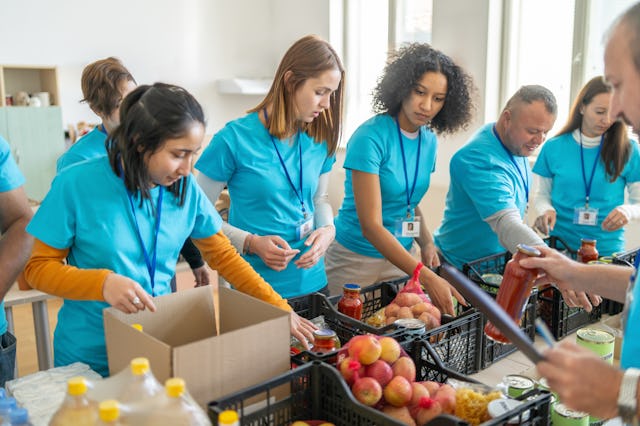What Food Pantries Want You To Know Right Now
Your donations can make an even bigger impact than you realize.

Food pantries are always in need this time of year, but with the government shutdown and federal food assistance basically nonexistent, a lot of people are wanting to help even more. Whether it’s donating food to a food pantry or volunteering to organize donations, it’s important to know what food pantries actually need from everyone right now. Every season, you see memes and posts and advice on the things to donate, but is there some special way we all could be helping to maximize our efforts right now?
“At our food bank, we do our best to stock items that fit the way our guests actually cook and eat,” says Nadya Sanchez, family engagement coordinator at Segue Blackstone Valley Pantry. “People often think of canned goods first, and those help, but things like rice, corn flour, pasta, beans, lentils, and oil are what most families reach for right away.”
It’s so easy when donating to just grab a bag of rice and dry beans and call it a day, but it’s also important to think about what other people are donating and try to give a variety of options.
Ian Dixon, volunteer manager at Second Harvest Food Bank of Central Florida, tells me that there’s a difference between food banks and food pantries, and that can impact what you donate. “Food banks are typically large distribution centers capable of receiving, storing, and processing tens, if not hundreds of thousands, of pounds of food,” Dixon says. “Food pantries are typically smaller in physical size, and can be easily overrun by too many of a single type of donation. Food banks will make sure dry beans and canned goods are distributed across a community so no one food pantry has an overabundance of one certain product.”
Beyond shelf-stable ingredients, Sanchez says fresh produce — think potatoes, onions, peppers, yuca, and other veggies — is always appreciated. You can check with your local food pantry or food bank to find out about refrigeration as well, especially for protein options like chicken, beef, pork, and fish.
When I ask Dixon specifically what families are asking for, he says, “Baby food and formula. These items are worth their weight in gold to parents visiting community food pantries. Also very high on the list are food items that kids can eat or easily prepare without help from Mom and Dad. Microwavable items, ready-to-eat items, and cans with pop-top lids are extremely helpful.”
Again, when you’re donating, really think about what people actually eat. How do they cook? What’s something easy and still comforting for them to serve their family?
I asked Dixon about “fun” items — things like cookies or muffin mix or brownies — that people often think of as frivolous or, at the very least, aren’t on their mind when it comes to food donations.
But dignity matters. And joy matters. And a family being able to have access to something sweet or something their kids really love or something that just makes their family happy (even a box of Little Debbie snack cakes!) is so important.
Dixon suggests donating these types of items, especially mixes and the like, with all of the ingredients donated together — think shelf-stable milk, oil instead of eggs, water bottles, etc. “We want to always consider our neighbors who may be living in hotels, shelters, their cars, or other temporary situations where preparing or cooking food can be a challenge. These folks don't have access to an oven, so prepackaged cookies and treats are a great option as well.”
And if you really want to make an impact, consider donating non-food items, too. “Hygiene items such as soap, shampoo, toothpaste, and diapers are also in constant demand,” Sanchez says.
Above all, remember that the people visiting these food banks and food pantries are just like the rest of us. Everyone is closer to needing help than we are to not needing help, and being able to give from your heart — and to give things that will truly not just satisfy a need, but brighten up a family’s dinner — is such a privilege. “When people donate with these needs in mind, it helps our guests prepare meals that feel familiar and comforting, and that matters a lot,” Sanchez says.
If you want to volunteer or donate, you can find local food banks and food pantries near you at Feeding America. Second Harvest Food Bank of Central Florida is currently participating in the Instacart Community Carts initiative, which allows anyone with an Instacart account to donate items that are delivered directly to them. You can also send in online financial donations at FeedHopeNow.org. Every dollar donated generates four meals for families facing hunger.